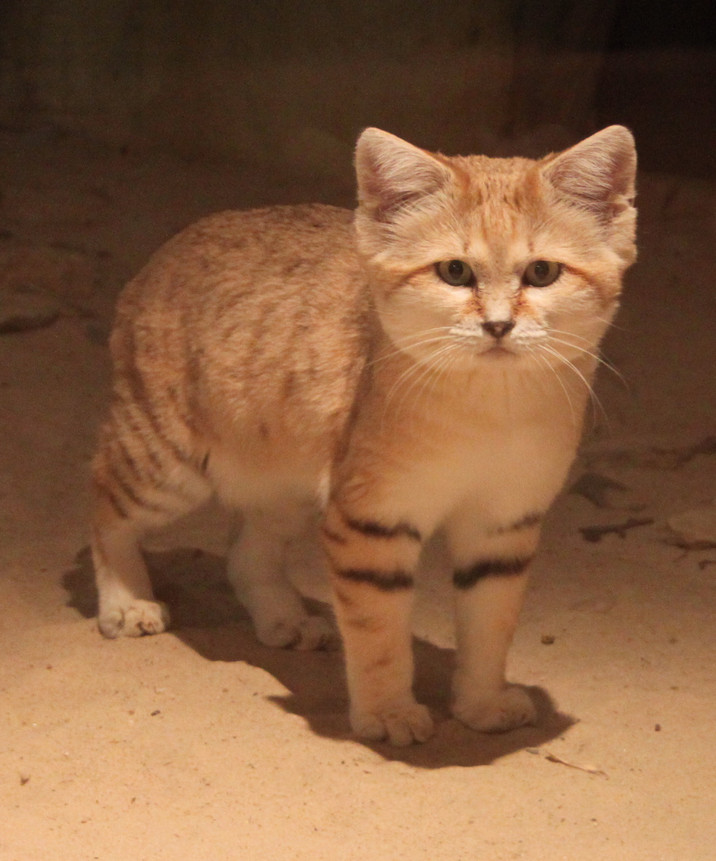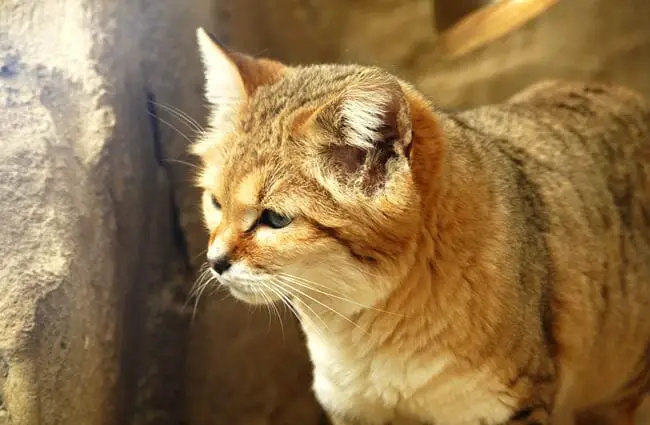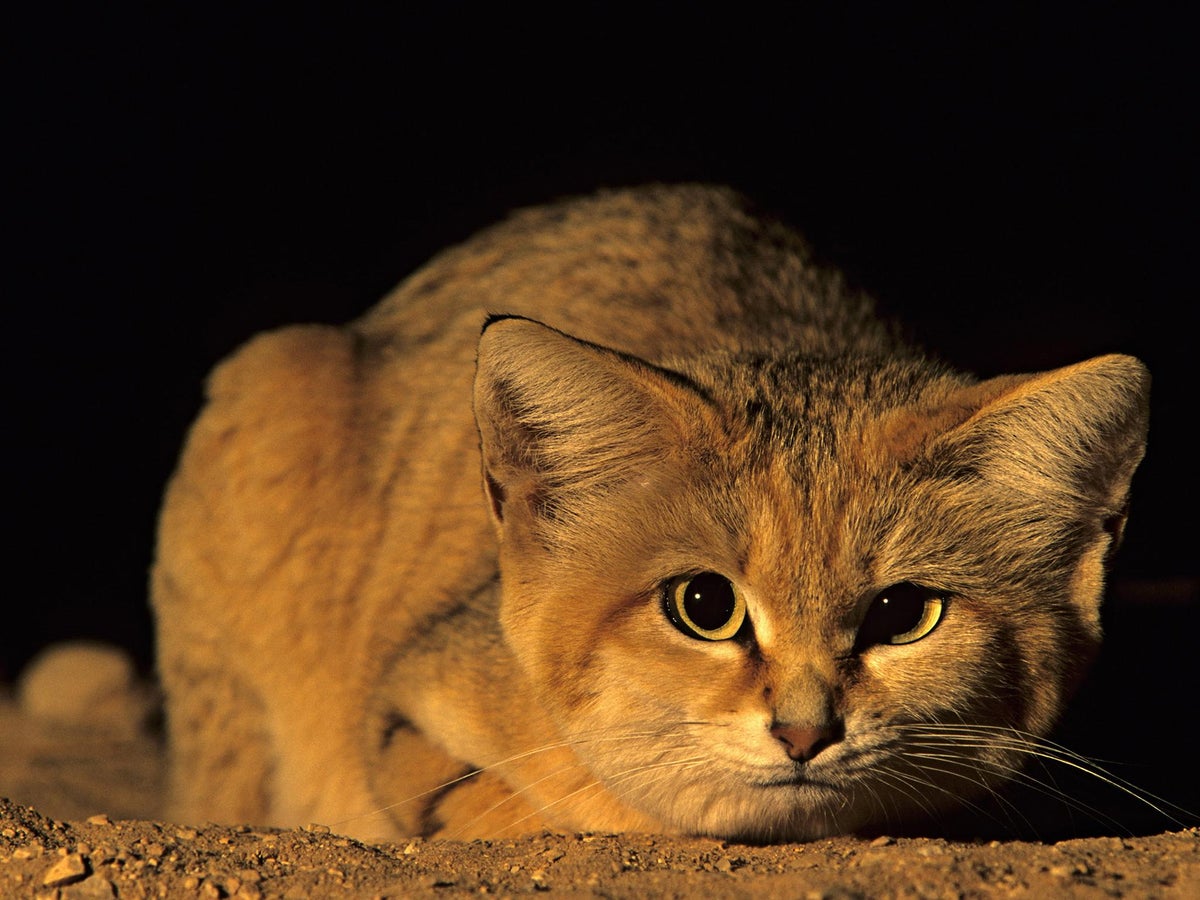[ベスト] desert animals sand cat 831182-How does a sand cat survive in the desert
· The sand cat is the only member of the cat family, both domesticated and wild cats, that can withstand extreme weather conditions These cats live in stony and sandy deserts stretching from Sahara Desert in North Africa to some regions in Middle East and Central Asia · The International Union for Conservation of Nature considers sand cats to be near threatened;The sand cat (Felis margarita) is a small wild cat in the Felinae subfamily It is distributed over African and Asian deserts Sometimes people call it "desert cat," but that is really the name of a different animal The sand cat does live in deserts, even the Sahara and Arabian Desert
Four Sand Cat Kittens Born At The Living Desert Check Out The Pics
How does a sand cat survive in the desert
How does a sand cat survive in the desert- · This adorable sand cat is practically a cartoon character — small, cute, and equipped with superpowers for living in the desert Found in northern AfricaThe sand cats are the wild cats, which are sometimes to be mistaken as the adorable kitten It behaves typically like a wild cat and sometimes behaves friendly towards people The sand cats prefer to live in the deserts With the furred feet, these cats are adaptable to the desert environment and can tolerate both cold and hot conditions



What Are Sand Cats And What Are Their Natural Predators Quora
/04/ · The sand cat is a type of feline that spends nearly all its life in the desert While they may not look that much different from an ordinary house cat at first glance, a closer look reveals just how wellbuilt these animals are to survive in such a punishing environment · Fm thinobia – Turkestan Fm scheffeli – Pakistan Fm harrisoni – Arabia, Jordan (Pictured on both pages) Size and Appearance Sand Cats weigh in at 48 pounds and reach lengths of 2936 inches, and heights of 1012 inches It has a dense soft fur that is a pale sand or gray color above and paler underneathDesert Animals with Examples Learn the names of desert animals with example sentences Some types of the camel have two humps and others have one
· Animal Files – Sand Cats The only Cats That Live in the Desert Sand cats can be found deep in both sandy and stony deserts, far away from any source of water The sand cat · The sand cat, Felis margarita, is native to North Africa, Southwest Asia, and Central Asia At 24–30 centimeters (9–12 in) tall, the sand cat weighs 1–3 kilograms (3–7 lb) and comes with a perfect suite of adaptations that make this animal uniquely capable of handling the challenges of desert lifeThe Sand Cat (Felis margarita) is a small wild cat that is uniquely adapted to its desert habitat Sand Cat adaptations include very large, triangular ears to detect the movement of small prey underground and at a distance
As the name suggests, the sand cat is the only feline (cat family animals) who lives in the desert Sand cat has adapted to this climate in their own unique way First, Sand cats can protect themselves against extreme desert conditions, like surface temperatures that rise to 124 degrees F in the daytime and drop to 31F degrees at nightSand Cat Sand Cat Share Facebook Twitter Email Location The Desert The Desert is a glassdomed building designed to recreate an arid, colorful desert Walk among freeflight birds, towering saguaros and watch the racing roadrunners , · The sand rat or the fat sand rat is a rodent native to the deserts of North Africa and the Arabian Peninsula all the way from Mauritania through Egypt, Sudan and Saudi Arabia They are highly adaptive rodents and can sometimes be found in wetlands along the coast




Three Newborn Sand Cat Kittens Melt Our Hearts From The Grapevine




Sand Cat Simple English Wikipedia The Free Encyclopedia
· Predominantly found in the western part of Saudi Arabia, sand cats are the only species of the cat family to live exclusively in the desert They can weigh between 5Oct , 15 Arabian Sand cat also known as Sand Dune Cat ,the only desert dweller of the wild cat family See more ideas about sand cat, wild cats, cats and kittensFeb 17, 18 The sand cat (Felis margarita), also known as the sand dune cat, is the only cat living foremost in true deserts This small cat is widely distributed in the deserts of North Africa, the Middle East and Central Asia The sand cat inhabits both sandy and stony desert, in areas far from water Having thickly furred feet, it is well adapted to the extremes of a desert environment
/sandcat.primary-c89d8309e3344414bec002329905281a.jpg)



8 Fascinating Facts About The Sand Cat




The Dramatic Search For One Of The World S Most Elusive Creatures Sand Kittens From The Grapevine
· Sand cats, also known as "sand dune cats," are desert dwelling felines native to Northern Africa, Central Asia, and the Middle East While these cute cats look quite similar to your average housecat, be warned they are 100% wild animals Sand cats have not been domesticated in any way, and are actually ferocious little predatorsDegradation of their desert habitats is the largest threat to sand cat populations As a public health precaution due to COVID19, the Smithsonian's National Zoo and Conservation Biology Institute has updated its hours and entry requirementsA desert is a region of limited water and a vast amount of sunlight Depending on the location of the desert, animals and plants native to deserts are camels, peccaries, bats, coyotes, lizards, snakes, woodpeckers, scorpions, different types of cacti, creosote bush, black sage and ocotillo Animal adaptations for living in the desert




Zoo Volunteer Miscellaneous Mammals The Sand Cat




How Do Animals Get Water In The Desert Quora
· 2 They Are the Only Cat That Lives Primarily in the Desert While some cat species, such as bobcats, pass through desert landscapes, the sand cat · Baby Sand Cats Kittens of the Desert by The Zookeeper · April 4, 13 Born to Rotem and Sela, four adorable baby sand cats recently came into the world in Tel Aviv, Israel, giving the country its first group of the species babies in twenty years The only feline species that can survive in a true desert, the sand cat is known for its · The sand cat (Felis margarita harrisoni) has a wide but apparently disjunct distribution through the deserts of northern Africa and southwest



Four Sand Cat Kittens Born At The Living Desert Check Out The Pics




How To Draw A Sand Cat
The smallest cat species in Arabia, the sand cat (Felis margarita) is well adapted to its arid desert habitat, obtaining all the water it needs from its foodSand cats (Felis margarita) kind of look like orange tabbies, but their head also has an unusually wide oval shape They also have two stripes on their front legs and entrancing eyes, making it obvious they are not ordinary cats These small cats originate from the sandy deserts of Northern Africa and Southwest Asia · The sand cat may look like house cats but these beige beauties are the only cat to live predominantly in the desert and they're built to handle its extremes on especially hot days Sand cat The sand can reach temperatures of 80 degrees Celsius hot enough to burn a cat's feet Sand cats, however, have long fur that covers their pads protecting them from the hot Arabian sand



I Can Has Cheezburger Sand Cat Funny Animals Online Cheezburger




Sand Cat The Animal Facts
· There are a lot of dangerous desert animals roaming under and on the hot sand every day Speaking of dangerous desert animals, we have a shortlist to introduce you today You will find 10 most dangerous desert animals that normally like to greet venturers on their landSand cats are solitary, and females give birth alone Distribution Sporadically distributed in sandy desert in the Sahara region of North Africa, through the Middle East and Arabian Peninsula to Turkmenistan, Kazakhstan and Pakistan Weight 2 – 3 kg (45 – 65 lb) Length 67 – 92 cm (26 – 36 in);Here is a list of 60 animal names that live in the desert with their useful examples used in sentences This is a helpful list with help you build more advanced vocabulary and quickly improve your English




Sand Cat Desert Animals




Can Sand Cats Kill Snakes Poc
· The animals of the Great Thar desert include numerous species of reptiles, desert scorpions, mongoose, red fox, chinkara, falcons, Indian bustard, blackbuck and a few species of wild cat 11 Great Basin Desert One Of The Four Deserts Of The United StatesDeserts of N Africa, Arabia and east to Pakistan Habitat Prefer dunes but will live in rocks Highlights Sand cats have an exceptionally large middle ear cavity making them extremely sensitive to the small scratching sounds of burrowing rodents as well as large ears that can swivel and funnel sounds to the inner ear · This is the Sand Cat – or Felis margarita, a little known species of desert cat In the wild it lives in areas that are too hot and dry for any other cat the deserts of Africa and Asia, including the Sahara It is the only desert species of cat known to us As such, this cat is one tough cookie Image Credit Flickr User MrGuilt




Keeping Sand Cats As Pets




There S A Sand Cat Baby At The Nc Zoo
Sand Cats may not look the part, but they are built to handle the extremes of one of the harshest environments on Earth Support Animalogic on Patreonhttps · Researchers captured firstever video of sand kittens in the wild Subscribe http//bitly/NatGeoWILDSubscribe#NatGeoWILD #SandCats #KittensAbout National · The Merriam Kangaroo Rat prefers rocky deserts, although it also thrives in clay, sand, and gravel deserts # 1 Amazing Desert Animals Sand Cat Sand cats have thick fur on their paws, including between the toes, which helps protect them from the scorching heat and harsh cold In addition, sand cats do not need much water at all




Sand Cat Animal Database Fandom




Everyone S Favorite The Sand Cat 10 Incredible Desert Animals That Can Take The Heat From The Grapevine
/08/ · The sand cat eats small animals like gerbils, hamsters, lizards and birds Sand cat is the only species of cat that inhabits deserts exclusively The sand cat feeds mainly on small sand dwelling rodents such as spiny mice (acomys spp), jirds (meriones spp) gerbils (gerbillus spp), jerboas (jaculus sppAbout 25 cm (1O in) tall · Sand cats have thick fur on their feet to protect them from the sizzlinghot desert sand Big Cat Rescue Water can be scarce in the harsh desert environment where the sand cats dwell, so they've evolved to get most of their moisture requirements from the prey they eat Baby Animal Zoo Sand cats are solitary animals that live in caves



Sand Cat Zooborns




Sand Cat Facts And Personality Cats In Care
· And out here in the scorching desert, the sand cat is bound to face venomous snakes — luckily for the cat, it's an expert snakekiller Sand cats can run as fast as 25mph Credit Tambako The Jaguar/Flickr Habitat degradation is the major threat to the sand cat, which is listed as "near threatened" by the IUCNThe smallest cat species in Arabia, the sand cat (Felis margarita) is well adapted to its arid desert habitat, obtaining all the water it needs from its foodPrey capture is facilitated by the sand cat's highly sensitive ears, which are large and triangular, and capable of detecting noises from animals both above and below the surface of the sandAnother common name for this species is the Sand Dune Cat It is the only relative member that lives deep in the desert, and is found in northern Africa or central and southwest Asia They are well adapted to sand and stones, and surviving at great distances from water Did you know?




Learn 10 Things About The Sand Cat Who Lives In Morocco Kanbrik Com




Sand Cat Sand Dune Cat Felis Margarita Harrisoni Native To The Deserts Of The Middle East Stock Photo Alamy
The animal can be up to over 7 pounds They can have a head and body that grows up to almost 2 feet long3952 cm The desert is where one of the world's most interesting and formidable cats lives, the Sand cat It looks a bit like a domestic cat, though with the addition of furry paws, giant ears, and a very curious personality These cats are small and stocky, with short legs and a




Sand Cat Description Habitat Image Diet And Interesting Facts




Sand Cat Wikiwand




Sand Cats Of Morocco International Society For Endangered Cats Isec Canada



Sand Cat Information And Facts Cats For Africa




Keeping Sand Cats As Pets



Squee Spree C Mere Little One Daily Squee Cute Animals Cute Baby Animals Cute Animal Pictures Animal Gifs Gif Animals




27 A Beautiful Group Of Desert Sand Cats Kittens Ideas Sand Cat Cats And Kittens Cats




Animal Files Sand Cats The Only Cats That Live In The Desert




Baby Sand Cat Can You Resist By Woxys On Deviantart




Sand Cat Facts Diet Habitat Pictures On Animalia Bio




Sand Cats Science Policy



Sand Cat Cincinnati Zoo Botanical Garden




Wild Sand Kittens Have Just Been Caught On Film For The First Time Ever And They Re Too Adorable Bored Panda




Learn 10 Things About The Sand Cat Who Lives In Morocco Kanbrik Com




Sand Cat Smithsonian S National Zoo



What Are Sand Cats And What Are Their Natural Predators Quora




Sand Cat Kittens Filmed In The Wild For First Time Nat Geo Wild Youtube




Pin On Cats




Three Sand Cats Born At Zoo Boise News City Of Boise




Elusive Arabian Sand Cat Spotted After 10 Years Disappearance New Scientist




Species Of The Week Sand Cat One Earth




Sand Cat Wallpapers Animal Hq Sand Cat Pictures 4k Wallpapers 19




Sand Cat Wikipedia




Watch First Video Of Sand Cat Kittens Romping In The Wild Smart News Smithsonian Magazine




Sand Cat The Amazing Animal That Doesn T Need To Drink Water




Sand Cats Make Regular Japan Display Debuts At Zoos In Kobe Nasu The Mainichi




Sand Cats Where The Adults Are Kittens And The Kittens Are Also Kittens Bored Panda




Pin On Sectioned Wild Cats




Pin On Cat House




Watch Newborn Sand Kittens Delight At Israeli Zoo The Times Of Israel




Sand Cat Animals Wiki Fandom




Can You Have A Sand Cat As A Pet




Cute Small Animals Egyptian Sand Cat



Arabian Sand Cat Al Ain Zoo




Sand Cat Facts Photos Videos Sounds And News




Sand Cat Description Habitat Image Diet And Interesting Facts




Sand Cat Facts Diet Pictures Adaptations And Predators




Sand Cat In The Living Desert Youtube




The Cat S Out Of The Bag North Carolina Zoo



Q Tbn And9gcqmsv0mzgjgt8f6yqi0uwk 1gt6 Qhfj Jer0lkksi Usqp Cau



Catsg Sand Cat




85 Sand Cat Desert Cat Ideas Sand Cat Wild Cats Cats




First Japan Born Sand Cat To Make Public Debut At Zoo In Tochigi The Japan Times



Q Tbn And9gcqmsv0mzgjgt8f6yqi0uwk 1gt6 Qhfj Jer0lkksi Usqp Cau




Sand Cats Make Regular Japan Display Debuts At Zoos In Kobe Nasu The Mainichi




Learn 10 Things About The Sand Cat Who Lives In Morocco Kanbrik Com




Sand Cat Distribution Habitat Range Map And Subspecies




Sand Cat Felis Margarita Wild Cats Magazine




Keeping Sand Cats As Pets




Sand Cats Blastoff Readers Animals Of The Desert Patrick Perish Amazon Com Books




Sand Cat A Small Wild Cat Love Meow




First Ever Video Footage Of Wild Sand Cat Kittens In Morocco




Animal Files Sand Cats The Only Cats That Live In The Desert




Sand Cat The King Of The Desert Youtube




Sand Cat Facts Diet Pictures Adaptations And Predators




Sand Cat Smithsonian S National Zoo



Q Tbn And9gcq6qg1xdntcado2a22aqznfcunyy Bqrvnynwiuqzaezowuijai Usqp Cau




Saudi Animals In Focus On World Wildlife Day Arab News



Sand Cat Facts Photos Videos Sounds And News
:max_bytes(150000):strip_icc()/sandcat.hunt-3ca76a25617347eab85baacc1f5fab52.jpg)



8 Fascinating Facts About The Sand Cat




Sand Cat Facts Animals Of The Desert Worldatlas




Watch Newborn Sand Kittens Delight At Israeli Zoo The Times Of Israel




Sand Cat Smallest Wild Cat Dinoanimals Com




Sand Cat Kittens Spotted In The Wild For First Time And Captured On Camera Love Meow




Arabian Sand Cat Utah S Hogle Zoo




The Sand Cat A Small And Beautiful Animal Of The Desert Owlcation




Sand Cat Wikipedia




Elusive Arabian Sand Cat Spotted After 10 Years Disappearance New Scientist




Sand Cat The Amazing Animal That Doesn T Need To Drink Water




Sand Cat Facts Diet Pictures Adaptations And Predators




Rare Arabian Sand Cat Spotted By Scientists After Ten Year Search The Independent The Independent




Sand Cat Adaptations To Desert Habitat Videos Cats For Africa




Four Sand Cat Kittens Born At The Living Desert Check Out The Pics




What Animals Live In The Arabian Desert Worldatlas



Catsg Sand Cat




Desert Sand Cats The World S Smallest Wild Cat Species Are Coming To Japan




Sand Cat Facts Diet Pictures Adaptations And Predators




Sand Cat Desert Cat Felis Margarita Classification




Sand Cat Facts Diet Habitat Pictures On Animalia Bio




Sand Cat The Living Desert




Sand Cat Smallest Wild Cat Dinoanimals Com




Sand Cat The Animal Files



3




85 Sand Cat Desert Cat Ideas Sand Cat Wild Cats Cats


コメント
コメントを投稿